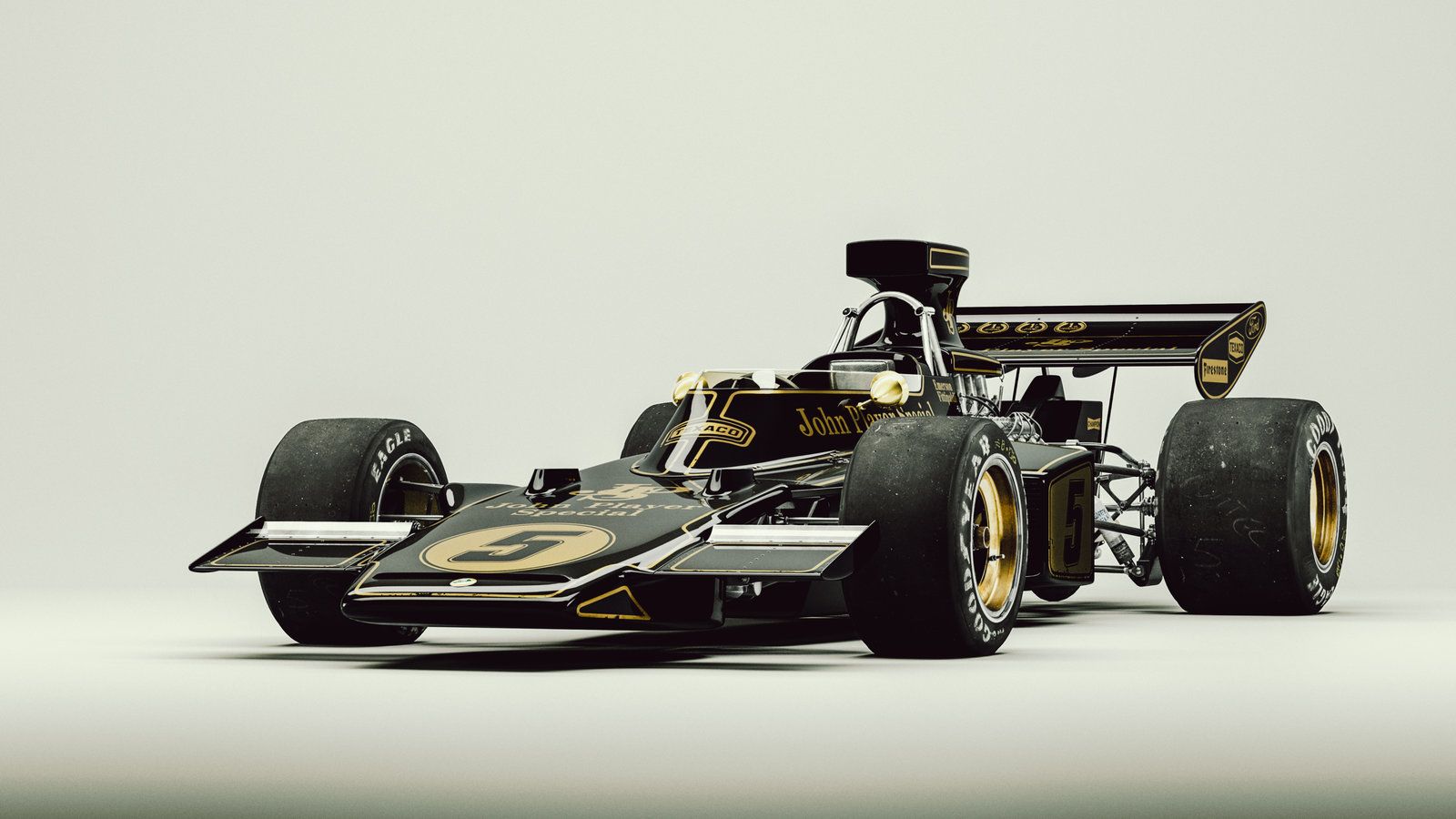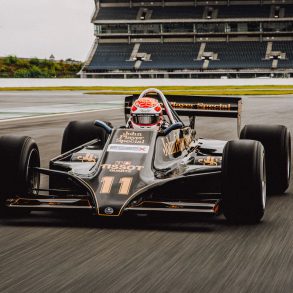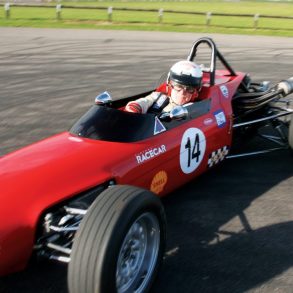Lotus 72
Car: Lotus-Ford 72 / Engine: 900 V8 Ford-Cosworth DFV / Maker: Lotus / Bore X Stroke: 85.7 x 64.8 mm / Year: 1970 / Capacity: 2,993 cc / Class: Formula 1 / Power: 440 bhp at 10,000 rpm
The car that most defined the whole first half of 1970s was the Lotus 72. Ask any long-time racing fan what car comes to mind when you say ‘Formula 1’ and at least half of them will think of wedge-shaped black and gold type 72. It’s partly because the Lotus 72 participated in as much as 6 seasons and 74 World Championship races but most of all the car owes its fame to its record of success – 20 Grand Prix wins, 2 Drivers Championships and 3 Constructors Championship titles, results unabridged for more than a decade. Design thinking was moving in great waves at the end of 60s: wings and aerodynamics, 4 wheel drive, tyre developments…
Lotus introduced the dominant Ford-Cosworth DFV engine to F1 in 1968 and built a new car for it, the Type 49. It was a simple design but yet a successful car, constantly developed during its three-and-a-half-years of lifetime. Unfortunately its intended replacements, the turbine powered Type 56B and 4WD Type 63 both failed and the Type 49 was retained in use for longer than was intended. Its successor simply had to be a big step forward.
The Type 72 was 2WD Cosworth-engined car designed by Maurice Phillippe and supervised by Colin Chapman. While it may seem that Lotus had gotten back to conventional thinking but that would not be altogether correct. The Type 72 had many novelties, some of which were of revolutionary importance. Its unique wedge shape was derived from the Type 56. While the water radiators were moved from the nose and split into two and situated on each side of the cockpit. This improved aerodynamic flow and moved the weight bias towards the rear end. This was considered important to ensure better traction because of the high engine power and torque. Steps in the same direction were the biggest-yet rear wing with 3 separate pieces and new Firestone tyres. The suspension was designed with torsion bar springs with progressive rate. Front suspension had an anti-dive geometry to prevent the car from burying it nose under braking (for what the Type 49 was notorious) and the rear suspension had anti-squat geometry to prevent the car from lifting its nose under acceleration. All of that should have ensured that the car had maintained the same ground clearance and thus consistent aerodynamic characteristics irrespective of the fuel load, or or whether it was under breaking or acceleration.
Unsprung weight was of newly found importance and consequently all 4 brakes were mounted inboard. The front brakes were attached to hollow brakeshafts and the front suspension consisted of upper and lower wishbones, torsion bars, anti-roll bar and telescopic dampers mounted inboard. Rear suspension incorporated lower wishbone, top link, only one radius rod since the suspension was relieved of braking loads (because the brakes were mounted inboard), torsion bars, anti-roll bar and telescopic dampers mounted inboard. They were soon resituated to outboard position because of overheating. The bathtub-type monocoque was made of sheet aluminum and had a subframe with the front suspension attached to the subframe and the engine/gearbox/suspension block attached at the rear.
As such, the car debuted at the Spanish GP on April 19, 1970. The drivers were Jochen Rindt and a young John miles. It was a poor showing and another outing, at the BRDC International Trophy at Silverstone 7 days later, produced a similar poor showing. The car was temporarily withdrawn from service and thoroughly reworked in the Lotus’ factory. Chassis 72 R2 (Rindt’s car) had both anti-squat and anti-dive removed to improve road holding in corners while 72 R1 (miles’ car) were less extensively modified with removal of only the anti-squat. The internal designation for these modifications was B (for removal of anti-squat) and C (for removal of both anti-squat and anti-dive). According to Maurice Phillippe, the trouble with the anti-dive suspension was that it gave the driver very little “feel”. He could lap as fast with it as without it, but less consistently. Chapman would later wish that the team had stuck with both longer before giving up.
The Type 72 came good after modifications and Rindt went on to win 4 consecutive races and ensure a huge lead in drivers’ table. Also, a major innovation appeared at the British GP: an airbox. The airbox is an aerodynamically shaped air intake sealed to the engine inlet trumpets which increases the pressure of the air which enters the engine and thus increases power.
However, the fairy tale was to be interrupted by tragedy. On Saturday morning’s free practice in Monza Rindt tried his 72C with no wings. This arrangement was thought to be better suited to the high-speed Italian circuit. While braking from maximum speed on the entry to the famous Parabolica, Rindt’s car snapped to the left, hit the poorly installed safety barriers and was demolished. Jochen Rindt died from his injuries. The probable cause of the accident was a failure of one of front brakeshafts due to poor manufacturing. Jochen Rindt was replaced in the team by a young Brazilian named Emerson Fittipaldi who rose to the challenge magnificently and won the penultimate race of the year in USA to clinch world titles for both Jochen Rindt and Team Lotus.
1971 was a low year for Lotus. The Rindt accident hung as a dark shadow over the team, there were legal problems and Fittipaldi had a road accident. All that added up to only a handful of podium places and no wins. The D specification was introduced on Fittipaldi’s car at Monaco: rear suspension gained one more radius rod and the lower wishbone was replaced by parallel links. Further modifications on the cars saw a new one-piece rear wing and a different oil tank design.
The cars were repainted for 1972. Being red and white with gold stripes before, they now became black and gold and would hence be known as ‘John Player Specials’ due to the sponsorship agreement. One of the most famous liveries in history of Formula One was thus created. The cars continued to run under the D specification. The oil tank was further modified and the rear wing was pushed ever further back to increase rear downforce. New regulations demanded thicker protection of the fuel tanks and the cars were modified accordingly. It was a successful year. Fittipaldi won 5 races and was crowned World Champion, still the youngest in the sport at the age of 25 yr. 9 m. He clinched the title with a win at the Italian GP at Monza. Coming to Monza, the Lotus transporter ad an accident and both cars were damaged. The team shipped a spare as quickly as possible and Fittipaldi was left with only one car for qualifying and the race while his teammate had to skip Monza. Luckily Fittipaldi did everything right.
In 1973 Tyrrell fielded a team with both Jackie Stewart and Cevert able to win races, Lotus decided to pair Fittipaldi with someone of equal ability. Ronnie Peterson, the rising star from Sweden and 1971 runner-up was signed. 1973 saw new regulations to be imposed from the Spanish GP on. They incorporated a 20cm wider bodywork with mandatory deformable structures. Phillippe left the team and the new designers were Martin Ogilvie and Ralph Bellamy.
The first 2 races in South America were however held under 1972 regulations. Lotus ran 72D cars for Fittipaldi and Peterson. Fittipaldi won both races and Peterson showed very strongly too qualifying on pole in Brazil, only his second race for the team. In Brazil these old cars were still heads and shoulders over all the opposition setting times 1.5 seconds quicker than fastest non-Lotus runners. The immortal design was still at its very best. However, later in the season the cars had to be redesigned. Previously detachable, sidepods now were molded into monocoque making up the deformable structure. This specification was called ‘E’. Further modifications were on the rear wing, oil tank (as usual) and suspension which had to be extensively modified to suit ever-changing tyre designs. The new cars were better suited to the latest tyres and Lotus had to stretch its capacities to the limit to tailor the cars to ever-changing conditions.

1975 was a disaster – not surprisingly for a late-1969 design. By that time the cars were old and unsuitable for the latest generation of tyres. The weight bias was too much in the rear and the cars couldn’t heat the front tyres adequately. A wider front track was tried and also a longer wheelbase by 5 cm to cure it. Cable operated torsion bars were tried which worked only under tension. Later a combination of torsion bars and coils tried and a F specification car was introduced with coil springs instead of torsion bars at the rear. Nothing helped. Ickx left mid-season and Peterson fought to the end grabbing 2 points at the 72’s last race, the 1975 US GP.
More Lotus Race Car Research / Best Lotus Racing Cars Ecver
Nine examples of Lotus 72 were produced and now they can be located as follows:
R1, R4 Mary Foulston GB
R2 – Giulio Romani ITA (Rindt’s wreck)
R3 – Andrew & Michael Schrywer GB
R5 – Classic Team Lotus GB (wreck)
R5 replacement – Classic Team Lotus GB
R6 – David McLaughlin GB
R7 – Anonymous collector GB
R8 – Donington Collection GB
R9 – Classic Team Lotus
*R1 was rebuild to C specification and re-designated R4.
These cars finished its lifetime on low note after being used for much longer than intended but that must not overshadow the incredible performances they had been putting on for almost 5 years. Times have changed and there may never be another car like the fabulously successful and good looking Type 72.
Lotus 72 Entries & Results – FREE TO DOWNLOAD





















